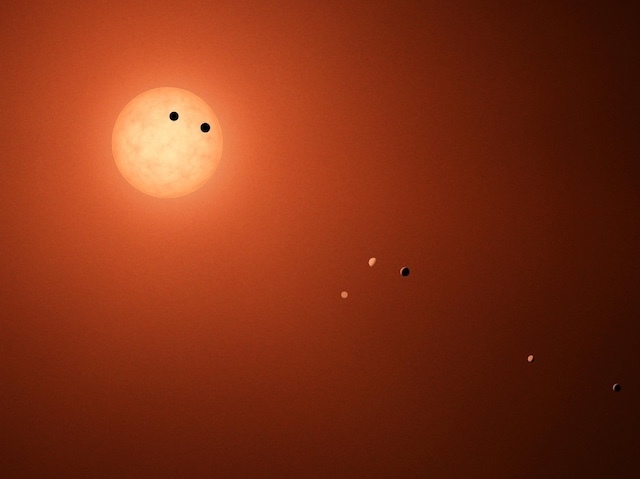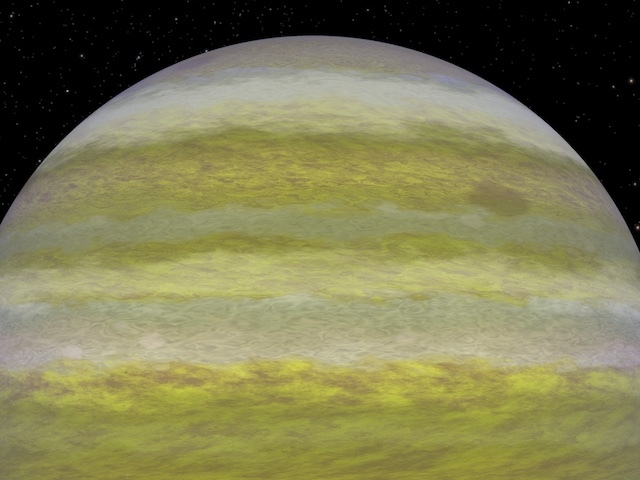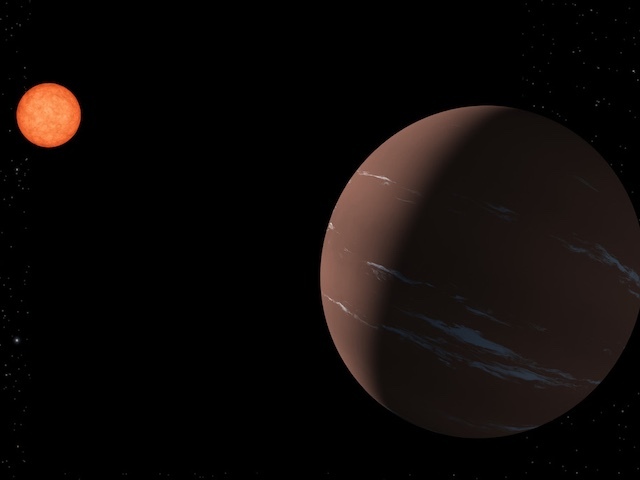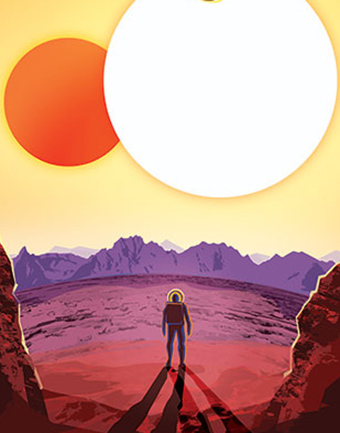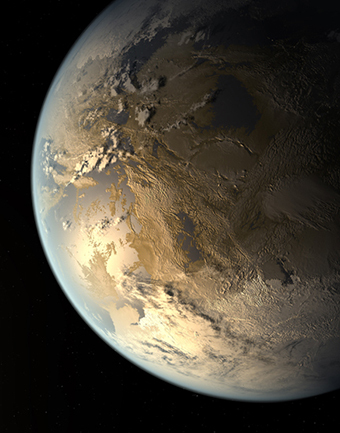News | January 8, 2020
NASA's Newest Planet Tracker Finds a Sky-high Perch
Desert winds rage as a small group of scientists huddles inside a mountaintop dome, preparing the way for a coming three-ton marvel: an exquisitely crafted, state-of-the-art planet hunter.
The dome rattles and the temperature drops as they work into the night. But by morning, the winds die down, and the garage-like door to the WIYN telescope, housed in a dome on Arizona’s Kitt Peak, rolls open.
On cue, a FedEx truck carrying the delicate instrument, built by Pennsylvania State University, chugs up the winding road to the dome — one of a cluster of more than 20 such domes that form a kind of astronomical village thousands of feet above the desert floor.
The new NASA-funded planet hunter, NEID (pronounced “NOO-id,” rhymes with "fluid"), would be unloaded, fine-tuned and aimed at the stars. Its job: to zero in on some of those stars, discovering new planets in orbit around them and bringing us ever closer to finding a world even somewhat like Earth.
NEID sees its "first light," and is ready to begin science operations.
“NEID will be one of the first instruments of its kind, with precisions of the right order to actually detect some of these small, terrestrial planets around nearby suns — which is quite exciting,” said Sam Halverson, an optical engineer at NASA’s Jet Propulsion Laboratory in Pasadena, California, who works on NEID, and on this day, is helping unload and install it.
NEID will convert the WIYN telescope into a planet hunter by allowing it to track wobbling stars. An unseen planet orbiting a star tugs it this way, then that, and the size of the wobble reveals the planet’s heft — or mass. The bigger the planet, the stronger its gravitational tug, and the wider the star’s wobble.
Small planets mean small wobbles, making them harder to detect by the wobble method — which goes by a more formal name, radial velocity, among astronomers. Another of NEID’s jobs is to demonstrate that “extreme precision radial velocity” can detect smaller planets, and perhaps one day a planet as small as Earth.
“What’s special about NEID is that we are trying to do this much more accurately with a level of sensitivity (greater) than anything that exists at the moment,” says Jayadev Rajagopal, head of NEID operations for the National Science Foundation’s Optical-Infrared Astronomy Research Laboratory. “The idea is that we will eventually want to be able to find Earth-like planets around Sun-like stars, because that’s our best chance of finding a world with life on it. NEID, I would say, is on a pathway to that.”
The morning’s work involves unloading equipment packed around NEID in the back of the FedEx truck. The scientists and engineers are glad to see that everything appears to have arrived safely after a cross-country trek from Penn State.
Then comes the delicate job: unloading NEID itself.
Despite its 6,000-pound weight, NEID must be lowered lightly onto the pavement at the threshold of the telescope dome. A heavy-duty forklift does the work, withdrawing NEID gently from the truck, turning it around and settling it to the ground inside the dome’s giant door.
Moving NEID further into the dome offers a reminder of the old arcade game, air hockey: A flotation system, switched on beneath the instrument, allows it to ride on an air cushion, so it takes just a few scientists to push it slowly into position.
“We turned on the air skids, which are basically small hovercrafts that lift the instrument to glide it into the room,” says Emily Hunting, site engineer for the WIYN telescope. “That was a little bit tricky, but we got it in, so everything’s fine.”
When it opens its eyes on the galaxy — the Milky Way, a wide, hazy band of light stretching from horizon to horizon on Kitt Peak’s dark nights — NEID will join a network of instruments on the ground and in space. Their shared purpose is not only to locate exoplanets, or planets around other stars, but to understand them more deeply.
NEID will confirm the presence of planets discovered by NASA’s TESS (Transiting Exoplanet Survey Satellite) mission, which launched in April 2018, and reveal details of the planets’ anatomy. TESS hunts for tiny dips in the light coming from nearby stars, a telltale sign of a planet crossing the star’s face.
But TESS’s search for shadows tells astronomers only part of the story — mainly, how large the planet is, and how long its “year,” or one trip around its star.
Such discoveries can be confirmed using a variety of methods. With NEID’s radial velocity measurements, scientists can pin down the planet’s mass. Combining that with TESS’s measurement of its width reveals the planet’s density — Is it rocky? Gaseous? — giving further clues to its potential habitability.
“Suddenly you get mass and radius, and you get density,” says Suvrath Mahadevan of Pennsylvania State University, NEID’s principal investigator. “Now you’re talking exoplanet population studies, right? You can do comparative (studies of exoplanets) now, as opposed to just discovery.”
A strong partnership between ground and space-based instruments, in other words, is critical to advancing our understanding of exoplanets.
“I think ground-based observatories have a very, very powerful role to play,” he says.
The science village at the top of Kitt Peak is one of many such sites around the world. It is leased from the Tohono O’odham Nation; the saguaro-studded landscape that unrolls beneath the high mountain is all Tohono O’odham land. To the south, a sacred mountain rises.
Signs posted around the peak warn of rattlesnakes, cougars, and bears. Narrow roadways link Kitt Peak’s many domes and outbuildings. The public is encouraged to visit, and can even make reservations for group observations of the cosmos — as long as they agree to have their headlights temporarily covered in red plastic when they leave, to avoid ruining telescopic views with unwanted splashes of light.
Among the many astronomically important instruments atop the peak, NEID will be a star, likely becoming even more critical to exoplanet science with the launch of NASA’s James Webb Space Telescope.
This behemoth, big enough to nearly cover a typical basketball court, will unfold its gigantic reflector in space in a pattern inspired by the Japanese art of origami. Once launched in 2021, the Webb telescope will have the power to scrutinize exoplanet atmospheres — to read the light from these planets like a bar code, revealing which gases and chemicals are present. Viewed with such an instrument from afar, Earth’s atmosphere would show oxygen, methane and carbon dioxide — strong indications of the presence of life.
But instead of taking sweeping cosmic surveys, like TESS, the Webb telescope will have to focus on individual planets, one by one. To increase its chances of finding interesting, potentially habitable worlds, other instruments must lay the groundwork, gathering data that will allow astronomers to choose the most promising candidates.
“Another major goal for NEID is to identify potential targets for the James Webb Space Telescope,” says Rajagopal, the NEID head of operations. “Webb will open the doors to characterizing these planets even further by actually looking for (the composition of their) atmospheres."
By early afternoon on the day of arrival, NEID is settled comfortably into place. Astronomers and engineers are busy connecting it to its port adapter, the component that will transmit light from the WIYN telescope into the guts of NEID — and the same instrument the small knot of astronomers had brought to life the cold, windy night before.
Kitt Peak installs another historic sky watcher. The future opens another window.


